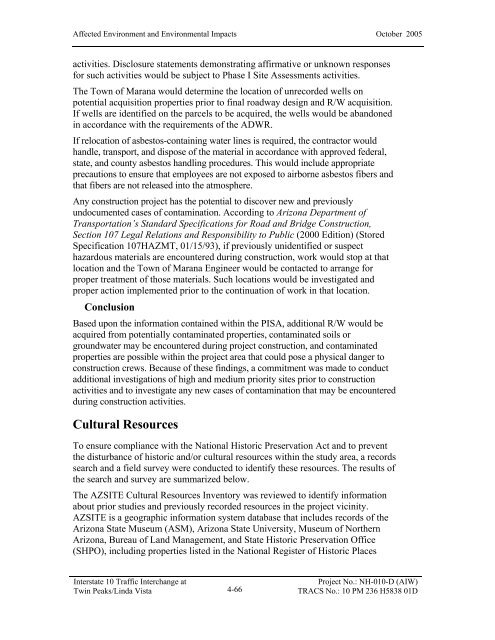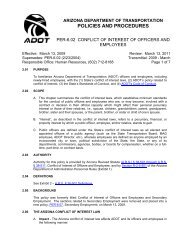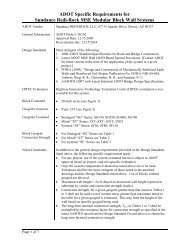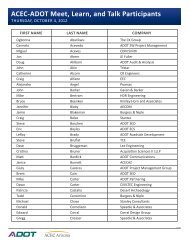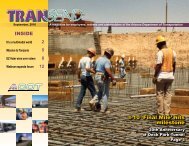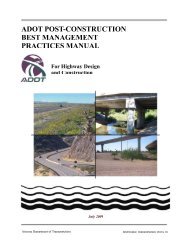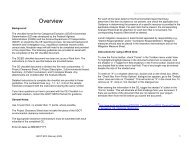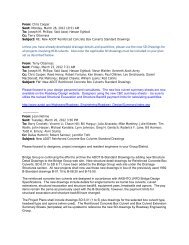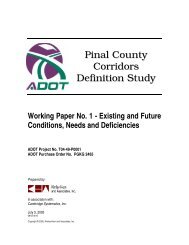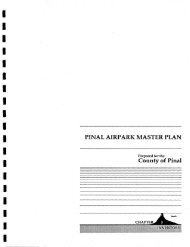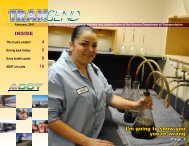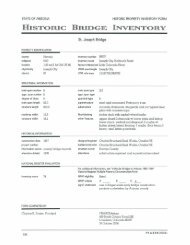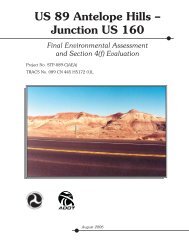I-10 Twin Peaks Traffic Interchange, Environmental Assessment
I-10 Twin Peaks Traffic Interchange, Environmental Assessment
I-10 Twin Peaks Traffic Interchange, Environmental Assessment
Create successful ePaper yourself
Turn your PDF publications into a flip-book with our unique Google optimized e-Paper software.
Affected Environment and <strong>Environmental</strong> Impacts October 2005<br />
activities. Disclosure statements demonstrating affirmative or unknown responses<br />
for such activities would be subject to Phase I Site <strong>Assessment</strong>s activities.<br />
The Town of Marana would determine the location of unrecorded wells on<br />
potential acquisition properties prior to final roadway design and R/W acquisition.<br />
If wells are identified on the parcels to be acquired, the wells would be abandoned<br />
in accordance with the requirements of the ADWR.<br />
If relocation of asbestos-containing water lines is required, the contractor would<br />
handle, transport, and dispose of the material in accordance with approved federal,<br />
state, and county asbestos handling procedures. This would include appropriate<br />
precautions to ensure that employees are not exposed to airborne asbestos fibers and<br />
that fibers are not released into the atmosphere.<br />
Any construction project has the potential to discover new and previously<br />
undocumented cases of contamination. According to Arizona Department of<br />
Transportation’s Standard Specifications for Road and Bridge Construction,<br />
Section <strong>10</strong>7 Legal Relations and Responsibility to Public (2000 Edition) (Stored<br />
Specification <strong>10</strong>7HAZMT, 01/15/93), if previously unidentified or suspect<br />
hazardous materials are encountered during construction, work would stop at that<br />
location and the Town of Marana Engineer would be contacted to arrange for<br />
proper treatment of those materials. Such locations would be investigated and<br />
proper action implemented prior to the continuation of work in that location.<br />
Conclusion<br />
Based upon the information contained within the PISA, additional R/W would be<br />
acquired from potentially contaminated properties, contaminated soils or<br />
groundwater may be encountered during project construction, and contaminated<br />
properties are possible within the project area that could pose a physical danger to<br />
construction crews. Because of these findings, a commitment was made to conduct<br />
additional investigations of high and medium priority sites prior to construction<br />
activities and to investigate any new cases of contamination that may be encountered<br />
during construction activities.<br />
Cultural Resources<br />
To ensure compliance with the National Historic Preservation Act and to prevent<br />
the disturbance of historic and/or cultural resources within the study area, a records<br />
search and a field survey were conducted to identify these resources. The results of<br />
the search and survey are summarized below.<br />
The AZSITE Cultural Resources Inventory was reviewed to identify information<br />
about prior studies and previously recorded resources in the project vicinity.<br />
AZSITE is a geographic information system database that includes records of the<br />
Arizona State Museum (ASM), Arizona State University, Museum of Northern<br />
Arizona, Bureau of Land Management, and State Historic Preservation Office<br />
(SHPO), including properties listed in the National Register of Historic Places<br />
Interstate <strong>10</strong> <strong>Traffic</strong> <strong>Interchange</strong> at<br />
<strong>Twin</strong> <strong>Peaks</strong>/Linda Vista<br />
4-66<br />
Project No.: NH-0<strong>10</strong>-D (AIW)<br />
TRACS No.: <strong>10</strong> PM 236 H5838 01D


